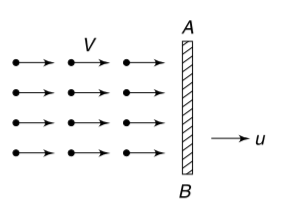Consider the situation of the previous problem. (a) Calculate the force needed to keep the sliding wire moving with a constant velocity v. (b) If the force needed just after t = 0 is F0, find the time at which the force needed will be F0 /2.
e=Bvl
i=(eR)=Bvl2r(l+vt)
(a)F=i/B=Bvl2r(l+vt)×lB
B2l2v2r(l+vt)
(c)Justaftert=0
F0=i/B=lB(lBv2rl)
=lB2v2r
F02=lB2v4r=l2B2v2r(l+vt)
⇒2l=l+vt
⇒t=(1v).
Topper's Solved these Questions
- ELECTROMAGNETIC INDUCTIONBOOK - HC VERMA ENGLISHCHAPTER - ELECTROMAGNETIC INDUCTIONEXERCISE - Questions for short answer
9 Videos
- ELECTROMAGNETIC INDUCTIONBOOK - HC VERMA ENGLISHCHAPTER - ELECTROMAGNETIC INDUCTIONEXERCISE - Objective 2
10 Videos
- ELECTRIC FIELD AND POTENTIALBOOK - HC VERMA ENGLISHCHAPTER - ELECTRIC FIELD AND POTENTIALEXERCISE - Objective 2
7 Videos
- ELECTROMAGNETIC WAVESBOOK - HC VERMA ENGLISHCHAPTER - ELECTROMAGNETIC WAVESEXERCISE - Exercise
8 Videos
Similar Questions
Knowledge Check
Consider the situations of the previous proble. Let the water push the left wass by a force F1 and the right wall byi as force F2.
AF1=F2BF1>F2CF1<F2Dthe information in insufficient to know the relation between F1andF2A vehicle needs an engine of 7500 W to keep it moving with a constant velocity of 20 ms−1 on a horizontal surface. The force resisting the motion is
A375 dyneB375 NC150000 dyneD150000 NA force F is needed to break a copper wire having radius R. the force needed to break a copper wire of radius 2R will be
AF2B2FC4FDF4
consider the situastion of the previous problem. Suppose the block of mass m1 is pulled by a constant force F1 and the other block is pulled by a constant force F2. Find the maximum elongation that the spring will suffer.
View SolutionA vehicle needs an engine of 7500 W to keep it moving with a constant velocity of 20 ms−1 on a horizontal surface. The force resisting the motion is
View SolutionConsider a situation similar ot that of the previous problem except that the ends of the rod slide on a pair of thick metallic rails laid parallel to the wire. At one end the rails are connected by resistor of resistance R. (a) what force is needed ot keep the rod sliding at a constant speed v? (b) in this situation what is the current in the resistance R? (c) Find the rate of heat developed in the resistor. (d) find the power delivered by the external agent exerting the force on the rod.
View SolutionConsider a situation similar ot that of the previous problem except that the ends of the rod slide on a pair of thick metallic rails laid parallel to the wire. At one end the rails are connected by resistor of resistance R. (a) what force is needed ot keep the rod sliding at a constant speed v? (b) in this situation what is the current in the resistance R? (c) Find the rate of heat developed in the resistor. (d) find the power delivered by the external agent exerting the force on the rod.
View SolutionA beam of gas molecules is incident normally on a plate AB. Each gas molecule has mass m and velocity V. The incident beam falls on an area A on the plate and all the molecule strike the plate elastically. Number of molecules in unit volume of the beam is n. When the plate is moved to right (see fig.) a force F1 is needed to keep it moving with constant velocity u (>V) . When the plate is moved to left with constant velocity u, an external force F2 is needed. Find F2–F1.

View Solution
